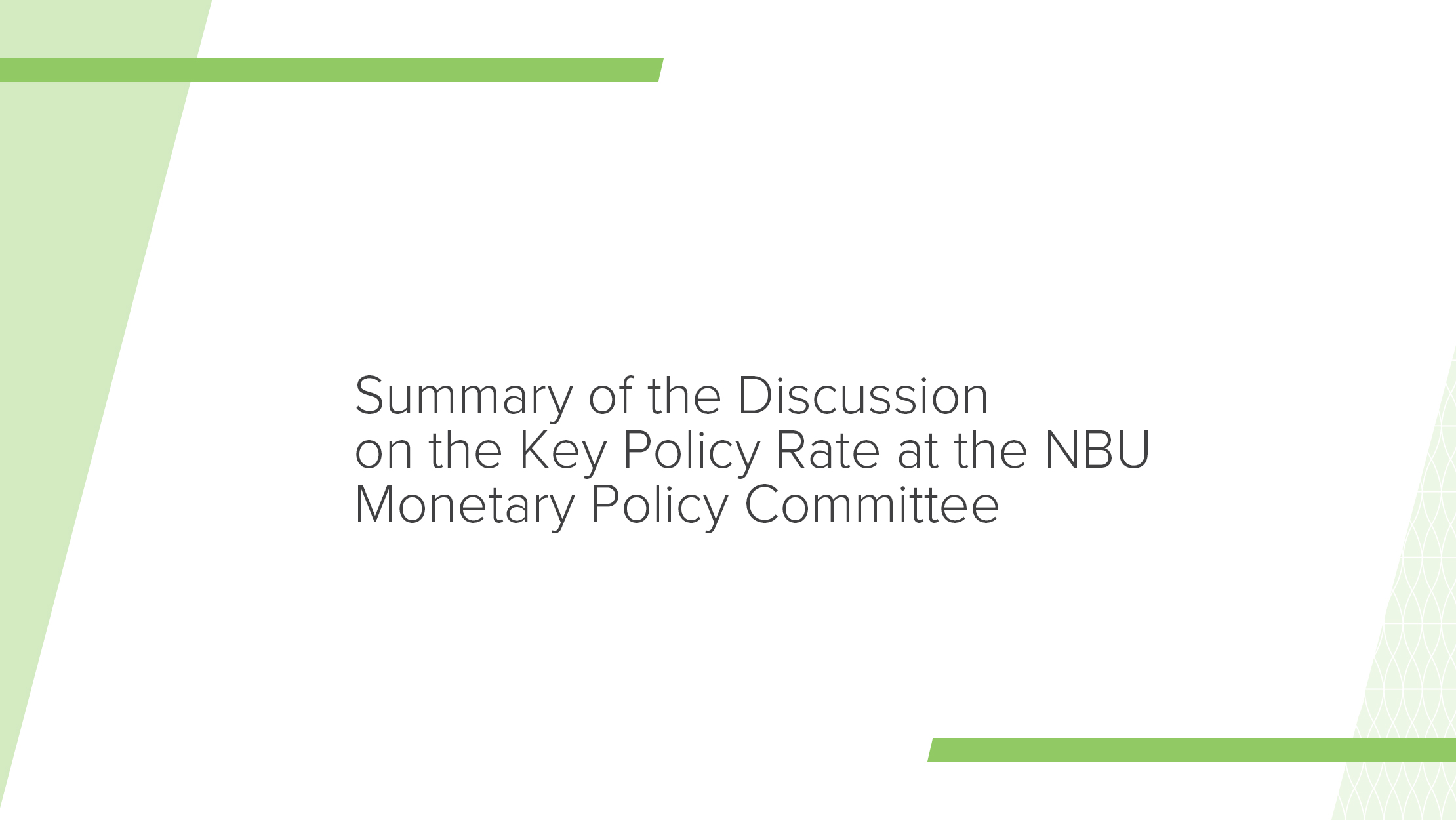Date of the meeting: 22–23 October 2019
Attendees: ten out of ten members of the NBU Monetary Policy Committee (MPC):
- Yakiv Smolii - Governor of the National Bank of Ukraine
- Kateryna Rozhkova - First Deputy Governor
- Roman Borysenko - Deputy Governor
- Dmytro Sologub - Deputy Governor
- Sergii Kholod - Deputy Governor
- Oleg Churiy - Deputy Governor
- Vitalii Vavryshchuk – Director of the Financial Stability Department
- Volodymyr Lepushynskyi-Acting Director of the Monetary Policy and Economic Analysis Department
- Yurii Polovniov - Director of the Statistics and Reporting Department
- Serhii Ponomarenko - Director of the Open Market Operations Department.
During the discussion, all of the MPC members unanimously supported cutting the key policy rate by 1 pp, to 15.5%, which is more rapid relative to the July macroeconomic forecast.
The underlying inflationary pressure, which is characterized by core inflation, is easing faster than anticipated in the NBU’s previous forecast (Inflation Report, July 2019), the MPC members noted in substantiating their position.
The main factor in the more pronounced slowdown of inflation in recent months has been a strengthening of the hryvnia. Favorable foreign exchange market conditions and the slowdown in price growth improved the inflation expectations of businesses, households, banks, and analysts, thus laying the groundwork for a further easing of monetary policy.
Lower underlying inflation pressures and improved inflation expectations are creating an obvious macroeconomic basis for an easing of monetary policy.
The excessively tight monetary stance would result in a rapid strengthening of the real effective exchange rate, posing the risk that the current account deficit of the balance of payments may increase. By contrast, lowering the interest rate will have a stimulating effect on lending and economic growth.
The participants also discussed the possible risks for the updated macroeconomic forecast, under which the economic growth will accelerate to 3.5%-4% in the coming years, while the inflation target of 5%, as expected, will have been achieved by the end of 2020. Among the key risks to the forecast, the MPC members named the delay in entering into a new cooperation agreement with the IMF and increased threats to macrofinancial stability – mainly due to Ukrainian court rulings. The materialization of these risks, as well as other negative events, can cause a deterioration in exchange rate and inflation expectations and, as a consequence, prevent inflation from declining to the target. In these circumstances, the NBU will be forced to pursue a tighter monetary policy than envisaged in the baseline scenario, under which the key policy rate is gradually reduced to 8% by the end of 2021.
The current decision to accelerate the key policy rate cuts is based on the key assumption of an updated macroeconomic outlook for successful cooperation with the IMF. The MPC members believe that the results of meetings between the Ukrainian government delegation and the IMF leadership in Washington, as well as the announced arrival of the IMF mission in November, give reason to expect that a new memorandum of cooperation will be signed and that Ukraine will have received the first tranche of the new loan by the end of the year.
During the meeting, the participants also discussed the estimated trajectory of the key policy rate. Most MPC members agreed that, in case the baseline scenario materialized, the monetary policy easing would continue. October’s reduction of the key policy rate by 100 bp slightly shifts its projected trajectory down from the July forecast. At the same time, the MPC members still believe that it is possible to reach a key policy rate level of 8% as of the end of 2021, provided that inflation steadily declines to the 5% target.
Further, the MPC members discussed the conditions for bigger cuts to the key policy rate. In particular, the MPC members believe, one of the main prerequisites for lowering the key policy rate more actively is the implementation of the measures envisaged by the Memorandum between the Cabinet of Ministers of Ukraine and the NBU on Cooperation to Achieve Sustainable Economic Growth and Price Stability.
The monetary policy easing can be accomplished faster if the impact of the hryvnia’s appreciation on inflation is more powerful and lasting than currently assumed, one MPC member noted.
Another participant of the discussion believes that the monetary policy easing may be slowed as the key policy rate approaches single-digits. This may take place, for instance, if the interest rates on foreign currency liabilities in the domestic market, in particular in the banking system, as well as on foreign currency domestic government bonds, do not decrease in the wake of the cheapening of hryvnia liabilities, the MPC member said. In this case, a sharp narrowing of the spread between hryvnia and FX yields will provoke an increase in the level of dollarization of the economy, which will increase the vulnerability of the latter and will require a tighter monetary policy than foreseen in the baseline scenario.
In addition, according to one MPC member, the NBU’s key policy rate forecast that was first published in July has a significant impact on the expectations of financial analysts, bankers, and economic journalists. Most of them predicted a drop in the key policy rate by 50 bp in October, based on the trajectory projected by the NBU in July. However, in its previous communications, the NBU emphasized that it was not obliged to adhere to the forecast of the key policy rate, and that the forecast may be revised in light of changing macroeconomic conditions. This MPC member is convinced that over time, market participants will consider these changes more carefully and take them into account in their own forecasts.
The decision to set the key policy rate at 15.5% per annum was approved by the NBU Board at the monetary policy meeting held on 24 October 2019.
For reference:
The Monetary Policy Committee (MPC) is the NBU’s advisory body created to share information and opinions on monetary policy formulation and implementation in order to deliver price stability. The MPC comprises the NBU Governor, other NBU Board members, and directors of the Monetary Policy and Economic Analysis, Open Market Operations, Financial Stability, and Statistics and Reporting Departments. The MPC meets the day before the NBU Board meeting on monetary policy issues. Decisions on monetary policy issues are made by the NBU Board.


